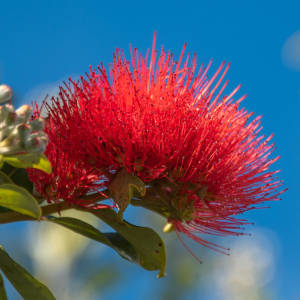Wax-eye's are Loving These Flowers
It it that time of year for the Feijoa's to flower and the little Wax-eye birds are loving the nectar. They are beautiful little flowers and very Christmassy looking and the fruit will be ready in Autumn.
John has had a cold all week and I was hoping that I wouldn't get it.. well I don't get a head cold, just really sore ears and throat today. What arrived in the post today was the apportionment to see the ENT specialist at the hospital for December 23rd. Since my bad virus in winter my ears still have been getting sore most weeks.. so I hope something can be done about it.
Some Facts on the Feijoa
Alternative Names: English: feijoa, pineapple guava, guavasteen; Spanish: guayabo grande, guayabo chico, guayabo del pais (Uruguay); Portuguese: goiaba serrana, goiaba verde, goiaba abacaxi (Brazil).
Origin: the cool subtropical and tropical highlands (less than 1000 m) of southern Brazil, Uruguay, western Paraguay, and northern Argentina.
General description: The feijoa is an evergreen, perennial shrub or small tree that grows to a height of 1-7 metres, and is grown as an ornamental or fruiting tree. It produces an attractive burst of red flowers in spring months. Leaves are coloured green on the upper surface and silvery grey on the under side.
The fruit are oval in shape and approximately 20mm to 80mm long and a dull green colour with a whitish bloom. The skin is thin and generally inedible, and encloses a whitish layer of granular flesh and a central mass of translucent jelly-like pulp. Each fruit contains 20 to 30 very small seeds.
Minerals: Feijoa fruit contains saponins, which are chemical compounds known as glycosides. Many saponins are thought to have anticancer properties and may lower cholesterol.
Feijoa fruit is a good source of the secondary plant metabolites known as flavonoids. Flavonoids are known to play an important role in the prevention of cancer, by inhibiting the growth of tumors. They are also an ally in the prevention of cardiovascular disease.
Taste/flavour: Feijoa tastes like a mixture of several other fruits, usually described as pineapple, guava, and strawberry. Sometimes the unique flavour is described as a combination of mint and pineapple. People who don’t like the taste liken it to medicine.
Uses: Feijoa is a versatile fruit, used in cakes, muffins, desserts, salsas, sauces, jams, jellies and curries. Commercial products include chocolate, tea, cereal, wine, vodka, preserves, sweets and cosmetic items. One of the biggest advantages of feijoa is that it can be frozen and cooked without loss of flavour or deterioration to its cream-coloured, fragrant flesh.
- 15
- 2

Comments
Sign in or get an account to comment.


